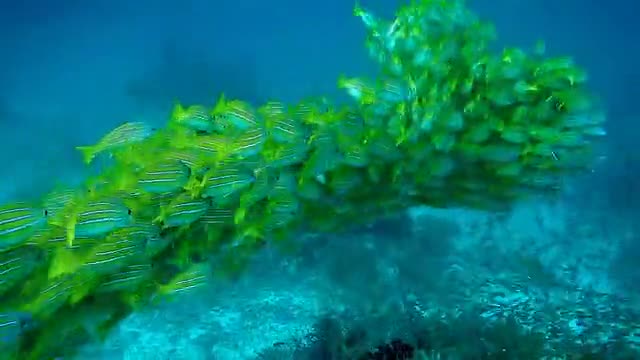Premium Only Content

Underwater life is so blessed 🐟🐟🐟| Yellow Tang Fish video 🐠🐠
Yellow fish: The yellow tang (Zebrasoma flavescens) is a saltwater fish species of the family Acanthuridae. It is one of the most popular marine aquarium fish. It is bright yellow in color, and it lives in reefs. The yellow tang spawn around a full moon. The yellow tang eats algae. The yellow tang has a white barb, located just before the tail fin, to protect itself.
Adult fish can grow to 20 centimetres (7.9 in) in length, and 1–2 centimetres (0.39–0.79 in) in thickness. Adult males tend to be larger than females. Yellow tangs are bright yellow in color. At night, the yellow coloring fades slightly, and a prominent brownish patch develops in the middle with a horizontal white band. They rapidly regain their bright yellow color during daylight. They can be aggressive, are prone to marine ich, and may damage coral within a reef tank. Male and female yellow tang look very similar. When mating, however, males change color and have a "shimmering" behavior which makes them identifiable. [6] The yellow tang has 5 dorsal spines along with 23-26 dorsal soft rays. The yellow tang also has 3 anal spines as well as 19-22 anal soft rays. There is a white spine on its caudal peduncle that it can use for defense. Its snout is moderately protruding. Its mouth is small with spatulate teeth that are place classed relatively close together inside of the yellow tang’s mouth. In juveniles, there are 12 upper and 14 lower teeth. In adults, there are 18 upper and 22 lower teeth.
The yellow tang is a marine fish that lives in reefs. The yellow tang is found by itself or in very small groups/schools. The yellow tang is mainly herbivorous and eats filamentous algae.
It is commonly found in shallow reefs, from 2–46 metres (6.6–150.9 ft) deep, in the Pacific Ocean (Ryukyu, Mariana, Marshall, Marcus, Wake, and Hawaiian islands),[3] west of Hawaii and east of Japan. There have also been reports that they have been found off the coast of Florida in the Western Central Atlantic. Their habitat is tropical with a temperature range of 24-28 degrees Celsius.[3] Hawaii is the most common place for aquarium harvesting, where up to 70% of the yellow tangs for the aquarium industry are sourced from.[7] Over 70% of the yellow tang's natural range is protected from collection and fishing.[8] The yellow tang is listed as "Least Concern" by the International Union for Conservation of Nature (IUCN).
The yellow tang has been recorded in waters around Florida, where it is not native.[
-
 LIVE
LIVE
The Quartering
1 hour agoAlex Jones Goes To WAR With Owen Shroyer, Are All Women Terrible?, Woke Backfire Of The Year!
9,173 watching -
 LIVE
LIVE
Awaken With JP
1 hour agoTrans Shooter is the Victim, Vaccines in Trouble, and Greta is Ugly - LIES Ep 106
816 watching -
 LIVE
LIVE
The White House
5 hours agoPresident Trump Makes an Announcement, Sep. 2, 2025
1,835 watching -
 LIVE
LIVE
MattMorseTV
2 hours ago $2.68 earned🔴Trump's Oval Office BOMBSHELL.🔴
1,406 watching -
 18:14
18:14
Real Estate
14 hours agoRising Prices PUSHING AMERICANS OVER THE EDGE
36 -
 1:43:35
1:43:35
Russell Brand
2 hours agoTrump Demands Big Pharma PROVE Covid Vaccine Is Safe – Did Pfizer LIE?! - SF626
106K25 -
 LIVE
LIVE
Due Dissidence
4 hours agoIsrael THREATENS Greta, InfoWars Host QUITS, FL Losing $200M on EMPTYING Alligator Alcatraz
816 watching -

Law&Crime
6 hours ago $0.41 earnedLIVE: Adelson Matriarch Murder Trial — FL v. Donna Adelson — Day 6
2.98K -
 1:08:04
1:08:04
Sean Unpaved
3 hours agoGridiron Shocks: Arch's Rough Start, Belichick's Tar Heel Tumble, & NFL Week 1 Buzz
20.3K -
 LIVE
LIVE
Professor Nez
2 hours ago🚨🇺🇸President Trump makes MAJOR Announcement from Oval Office TODAY!
271 watching